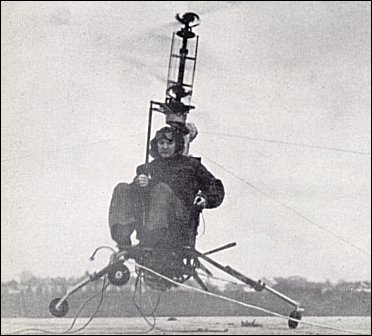Model 101, 1946
This model reproduced the main general features of the 'Strap-on', but the pilot now had a seat and a tubular tripod assembly with three small wheels to act as landing gear, and also a hanging stick to control the aircraft.
Model 102, 1947
Tests of the Model 101 revealed the need for several improvements, so that the 102, while somewhat resembling its predecessor, had a more powerful engine. Besides a directly engaging clutch, there was also a freewheeling device for auto-rotation in case of engine failure.
The two rotors, set at a distance of 2 feet (61 centimetres) from each other, consisted of a 4-foot (i-32-metre) tubular metal section centred at the hub; to these tubular sections the two spruce blades were attached.
The controls included collective, cyclic and differential pitch, the latter being obtained by rotating the stick handle which made the helicopter turn on its vertical axis.
Model 103, 1947
This model was similar to the previous ones, except that the rotor diameter was slightly increased and the distance between the two rotors somewhat greater.
Model 104, 1948
Once again this was an ultra-light single-seater helicopter with two co-axial contra-rotating two-bladed rotors of the same lineage as the firm's previous products. Model 104 was sent to the United Kingdom, where it remained, to be tested for the Ministry of Supply under the aegis of a British company, Hoppicopter Ltd.
P.Lambermont "Helicopters and Autogyros of the World", 1958





